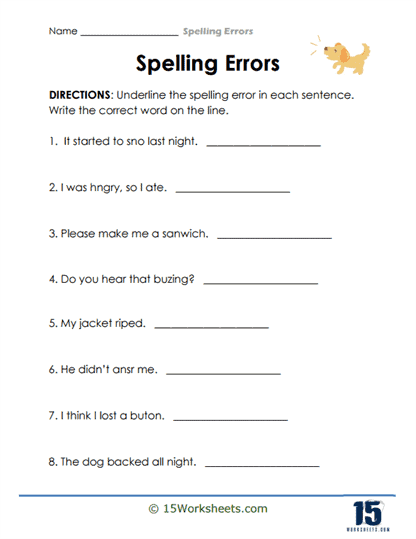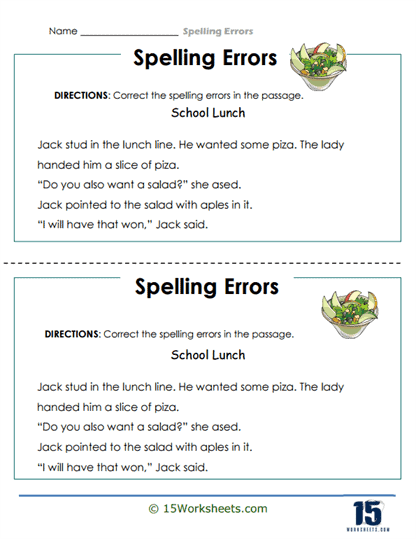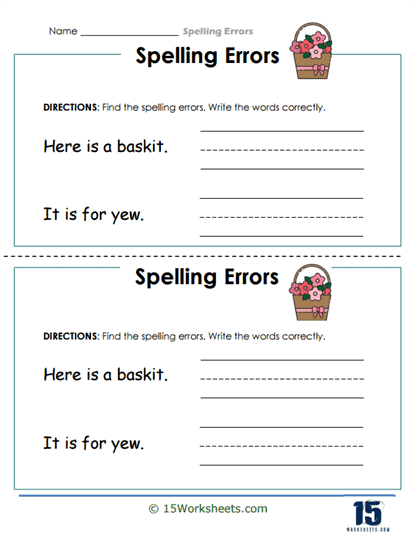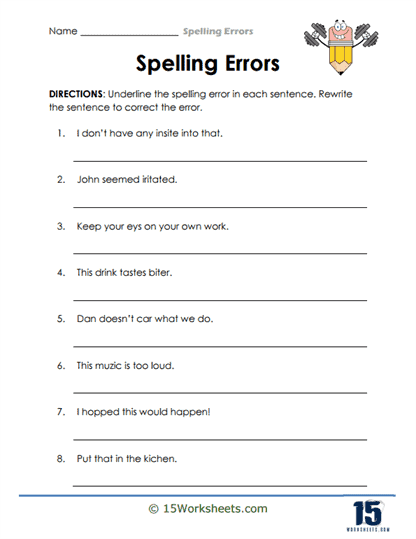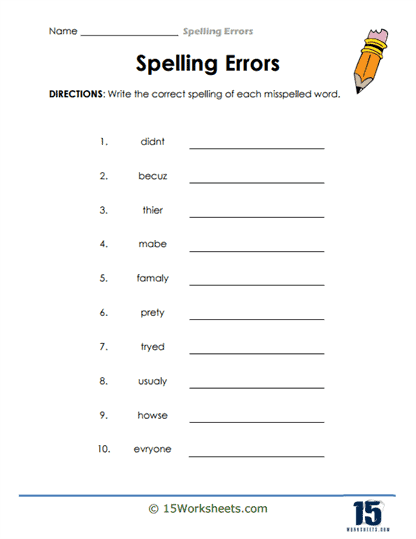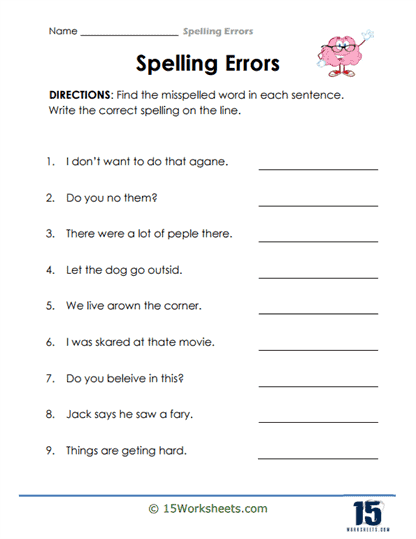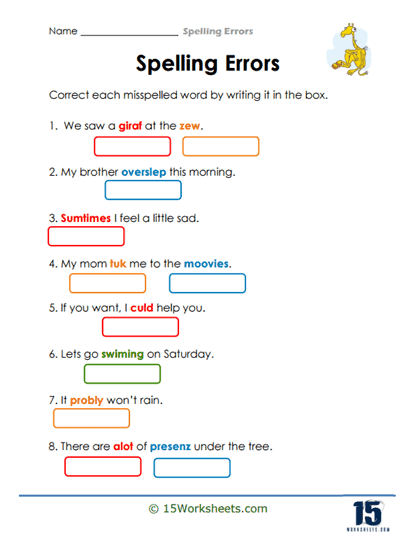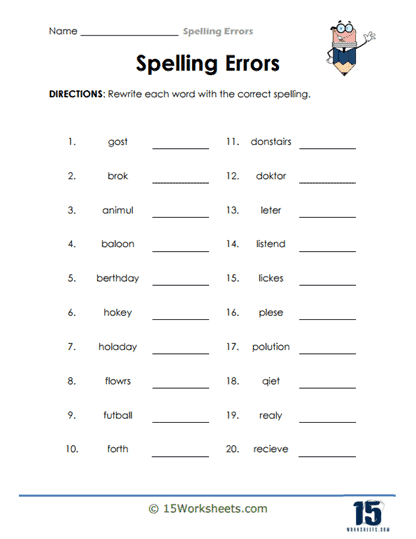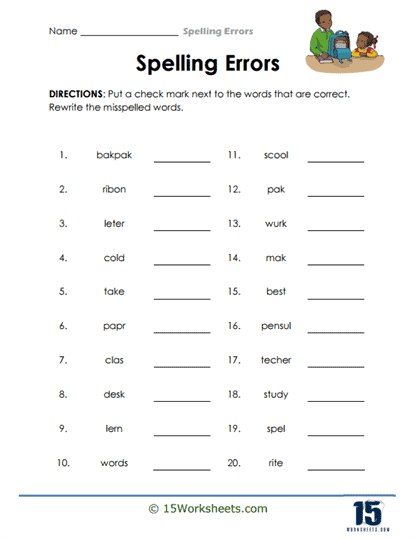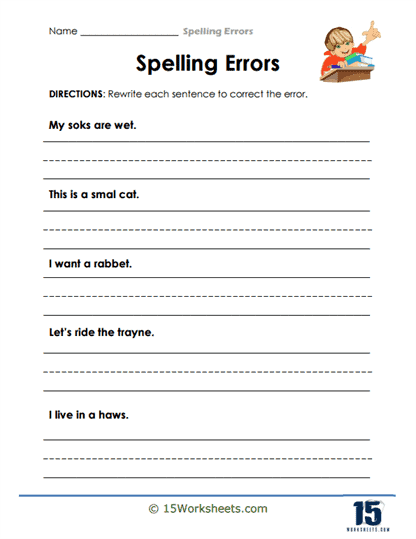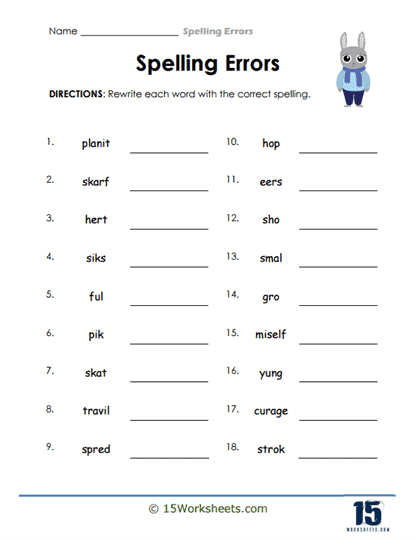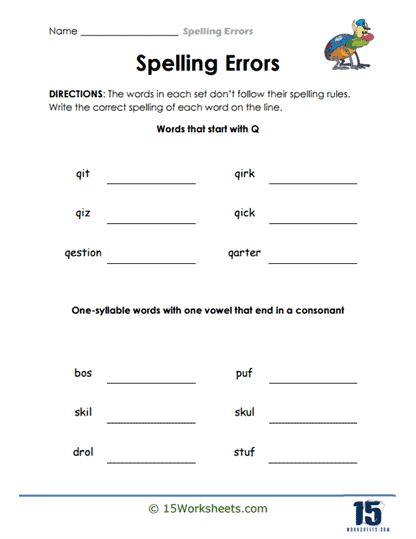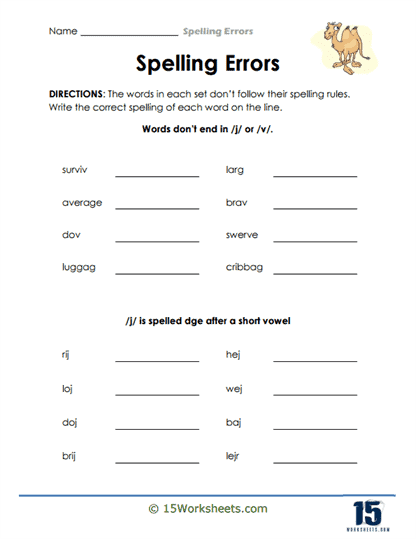Spelling Errors Worksheets
All About These 15 Worksheets
These worksheets can help students identify, correct, and understand common spelling mistakes. These worksheets typically provide sentences or passages containing deliberate spelling errors, prompting learners to find and correct them. The primary goal is to strengthen spelling skills by encouraging critical thinking and pattern recognition in the context of language. They also serve as a diagnostic tool for educators, revealing specific areas where students may need additional practice or instruction. They help students build confidence in their writing abilities as they learn to recognize and address errors independently. Over time, these worksheets foster better overall literacy skills, contributing to improved reading comprehension and written expression.
These worksheets include sentences, paragraphs, or word lists where spelling errors are embedded. Students are tasked with identifying and fixing the mistakes, sometimes with hints or word banks for guidance. The exercise not only corrects individual errors but also reinforces spelling rules and patterns, making the learning experience both corrective and preventive. By encountering spelling errors in context, students learn to apply spelling rules dynamically rather than memorizing them in isolation. This contextual learning helps them understand how spelling affects meaning, such as distinguishing between homophones like “their” and “there.” The repetitive nature of these exercises strengthens memory retention, making it easier for students to spell words correctly in future writing tasks.
Working on fixing the spelling errors of others offers students a unique opportunity to sharpen their own language skills while contributing to a collaborative learning environment. By identifying errors, students reinforce their understanding of correct spelling patterns, linguistic rules, and exceptions. This process demands active engagement with the language, enhancing their ability to recognize and apply spelling rules in their own writing. Spotting and correcting errors fosters critical thinking and attention to detail, essential skills in both academic and professional contexts.
Collaborative activities that involve correcting spelling mistakes can also build interpersonal and communication skills. When students provide constructive feedback to peers, they learn to approach others’ work respectfully and effectively. This helps develop a sense of responsibility and teamwork, as they support the learning process of their classmates. Moreover, explaining corrections to others requires students to articulate their understanding of spelling rules, reinforcing their knowledge while helping peers improve-a mutually beneficial process.
Engaging in spelling correction encourages a growth mindset by normalizing mistakes as part of the learning process. Students become more comfortable with receiving and giving feedback, seeing errors as opportunities for improvement rather than failures. This practice nurtures resilience and a positive attitude toward learning, which are valuable beyond the classroom. By participating in this activity, students cultivate skills that will aid them in academic pursuits, workplace communication, and lifelong learning, making it an enriching exercise for all involved.
These worksheets are versatile and can be tailored to various learning styles, making them a valuable tool for diverse classrooms. For visual learners, colorful worksheets with highlighted errors may be effective, as they draw attention to the specific mistakes and make the corrections more memorable. These visual cues can also be paired with images or diagrams to create connections that reinforce memory. For kinesthetic learners, interactive activities like cutting and pasting corrections or writing the corrected words multiple times can enhance retention, as they engage with the material physically and repetitively. These hands-on strategies not only make learning more enjoyable but also help solidify spelling rules through muscle memory. Audio learners might benefit from pairing these worksheets with spelling dictation exercises, as hearing the words spoken aloud and repeating them reinforces auditory connections. This multimodal approach ensures that all types of learners can engage meaningfully with the material, catering to individual needs effectively.
These worksheets reveal common spelling difficulties, allowing educators to identify patterns of errors and misconceptions that need addressing. With this information, teachers can tailor their instruction to focus on problem areas, ensuring that lessons are both targeted and efficient. Worksheets also promote autonomy as students practice and self-correct, reducing the need for constant teacher intervention while ensuring progress. This fosters a sense of responsibility in students, encouraging them to take ownership of their learning journey. These worksheets can serve as a low-pressure way for students to demonstrate their skills, helping build confidence and competence in spelling without the stress of formal assessments.
Homeschooling parents can use these worksheets to integrate spelling practice seamlessly into daily lessons, making them an essential resource for home education. They offer a structured yet flexible way to address spelling issues, enabling learners to progress at their own pace without the rigidity of traditional classrooms. Parents can easily adapt the worksheets to align with specific topics or themes being covered in their curriculum, creating a cohesive learning experience. Additionally, they are ideal for multi-age homeschool settings, as worksheets can be customized to suit different grade levels and abilities, ensuring that every child in the household is appropriately challenged.

